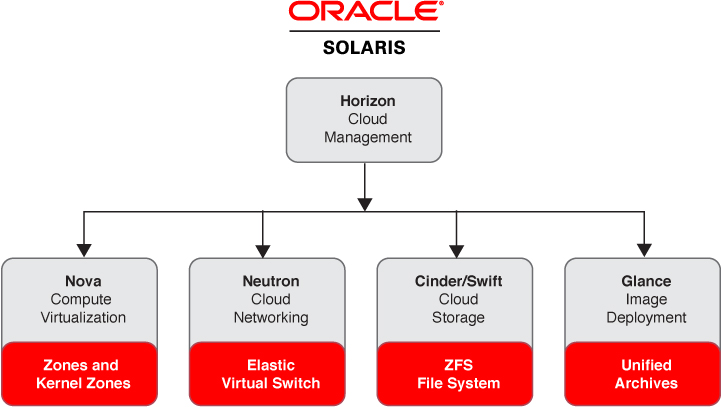How OpenStack Is Integrated Into Oracle Solaris
Oracle Solaris 11.2 includes an OpenStack distribution that is completely integrated with the core technologies of Oracle Solaris 11. OpenStack in Oracle Solaris 11.2 enables you to create an enterprise-ready IaaS (Infrastructure as a Service) private cloud so that users can quickly create virtual networking and compute resources by using a centralized web-based portal.
The following figure shows Oracle Solaris 11.2 features that are used to implement OpenStack services. These relationships are described below the figure.
Figure 1-1 Oracle Solaris and OpenStack Integration

The following OpenStack services are provided in Oracle Solaris 11.2:
-
The Nova compute virtualization service provides a cloud computing fabric controller that supports a variety of virtualization technologies. In Solaris, virtual machine (VM) instances are kernel zones or non-global zones. Zones are scalable high density virtual environments with low virtualization overhead. Kernel zones also provide independent kernel versions, enabling independent upgrade of VM instances, which is desirable for a multi-tenant cloud.
For more information about Oracle Solaris zones, refer to the different zones documentation in the Oracle Solaris 11.2 Library.
-
The Neutron network virtualization service provides network connectivity for other OpenStack services on multiple OpenStack systems and for VM instances. In Solaris, network virtualization services are provided through the Elastic Virtual Switch (EVS) capability, which acts as a single point of control for creating, configuring, and monitoring virtual switches that span multiple physical servers. Applications can drive their own behavior for prioritizing network traffic across the cloud. Neutron provides an API for users to dynamically request and configure virtual networks. These networks connect interfaces such as VNICs from Nova VM instances.
For more information about Elastic Virtual Switches, see Chapter 5, About Elastic Virtual Switches, in Managing Network Virtualization and Network Resources in Oracle Solaris 11.2 .
-
The Cinder block storage service provides an infrastructure for managing block storage volumes in OpenStack. Cinder enables you to expose block devices and connect block devices to VM instances for expanded storage, better performance, and integration with enterprise storage platforms. In Solaris, Cinder uses ZFS for storage and uses iSCSI or Fibre Channel for remote access. ZFS provides integrated data services including snapshots, encryption, and deduplication. A Cinder driver is also available on the ZFS Storage Appliance.
For more information about ZFS, see Managing ZFS File Systems in Oracle Solaris 11.2 . Documentation on ZFS Storage Appliance is available at https://docs.oracle.com/en/storage/.
-
The Swift object storage service provides redundant and scalable object storage services for OpenStack projects and users. Swift stores and retrieves arbitrary unstructured data using ZFS, and the data is then accessible via a RESTful API.
-
The Glance image store service stores disk images of virtual machines, which are used to deploy VM instances. In Solaris, Glance images are Unified Archives. The images can be stored in a variety of locations from simple file systems to object storage systems such as OpenStack Swift. Glance has a RESTful API that enables you to query image metadata as well as retrieve the image.
Unified Archives enable secure, compliant, fast, and scalable deployment. The same Unified Archive can be used to deploy either bare-metal or virtual systems. You can use Unified Archives with the Automated Installer (AI) to rapidly provision many systems.
For more information, see Using Unified Archives for System Recovery and Cloning in Oracle Solaris 11.2 . An AI installation is a method of performing automated installation by using an AI image either on a media or a server. For more information, see Chapter 5, Automated Installations That Boot From Media, in Installing Oracle Solaris 11.2 Systems .
-
Horizon is the OpenStack dashboard where you can manage the cloud infrastructure and computing infrastructure in order to support multiple VM instances. The dashboard provides a web-based user interface to OpenStack services. See Using the OpenStack Dashboard for an example.
-
The Keystone identity service provides authentication and authorization services between users, administrators, and OpenStack services.
-
The Heat orchestration service engine enables developers to automate the implementation of an OpenStack infrastructure. The engine is driven by templates that contain configuration information and post installation operations to deploy a customized configuration.
Each OpenStack service is represented by one or more Service Management Facility (SMF) services. For example, see the list of SMF services in Table 3–1. SMF regulates OpenStack services, for example, by performing automatic service restart in case of failure or full service dependency checking for more precise and efficient startup.
The Image Packaging System (IPS) enables easy OpenStack system deployment and fast upgrade that is protected from failure. Boot environments (BEs) enable you to easily keep a backup environment when you update OpenStack systems. Each OpenStack service is delivered in its own IPS package to provide installation flexibility, including minimization. Each OpenStack service package delivers a unique user and group for that OpenStack service and an RBAC profile for administering that OpenStack service.